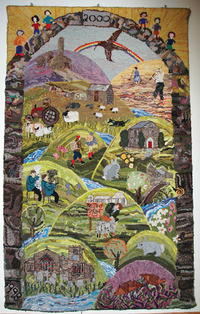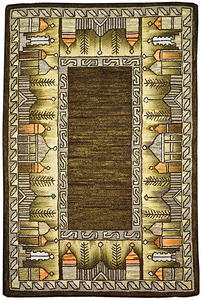Traditional Crewel, Traditional Hooking
The Secrets of Hooking Crewel Designs

Red monochromatic handbag—Chain stitch using five values of red and three values of gray. This simple design demonstrates very strong color planning.
Early crewel needlework encompassed a very limited color palette of golds, golden browns, and blues with sparse amounts of reds. This was most likely due to the limited scope of natural dyes. How fortunate we are today to have unlimited dyes and dye formulas to create rich and vibrant multi-hued color plans.
The secret to a successful crewel hooked rug is the color plan, repetition of the colors, and the ability to express the stitch contour of real crewel needlework. There was no need to conform to the rules of nature when color planning.
Perhaps the most used stitch in crewel needlework is the long and short stitch. In this stitch, you begin with the darkest value, varying the length of the stitches. Then you add the next-to-the-darkest value, allowing each stitch to feed into the darker values. Then proceed to the next value, thus creating a smooth transition of color. In rug hooking, the best way to replicate this technique is fingering values together. Today this technique is not popular because it is time consuming, but it works well when using a graded swatch. The second-best way is to create the change in value in the dye pot by dip dyeing. You can also use mock-shading by simply layering the values one after another, but the effect is not as soft.
If you are hooking a crewel piece which is not going on the floor, you may use French knots, chain stitch, and other types of Canadian stitches (developed by Margaret Rowan, a Canadian designer), which are very much in use today.
Most crewel rug designs are balanced through repetition or motif placement. The exception is on pillow tops and wall hangings. In these cases, it is up to the artist to carefully plan the balance of colors and thus create the continuity.
This is done using the primary hue of one motif to outline or accent an adjacent motif. How you complete that repetition will govern the success of your color plan.
Since a picture is worth a thousand words, I am showing you pieces which I own to demonstrate several techniques. I urge you, as a hooking artist, to experiment with this type of design. It will stretch your color planning skills because you can incorporate techniques that you cannot use in hooking realistic motifs. And, if you don’t like fine cut, there are plenty of designs appropriate for wider cuts.








